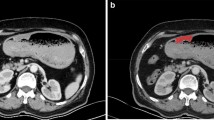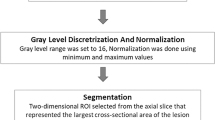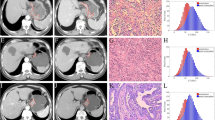Abstract
Objectives
To investigate the association between preoperative texture analysis from multidetector computed tomography (MDCT) and overall survival in patients with gastric cancer.
Methods
Institutional review board approval and informed consent were obtained. Fifty-six patients with biopsy-proved gastric cancer were examined by MDCT and treated with surgery. Image features from texture analysis were quantified, with and without filters for fine to coarse textures. The association with survival time was assessed using Kaplan–Meier and Cox analysis.
Results
The following parameters were significantly associated with a negative prognosis, according to different thresholds: energy [no filter] – Logarithm of relative risk (Log RR): 3.25; p = 0.046; entropy [no filter] (Log RR: 5.96; p = 0.002); entropy [filter 1.5] (Log RR: 3.54; p = 0.027); maximum Hounsfield unit value [filter 1.5] (Log RR: 3.44; p = 0.027); skewness [filter 2] (Log RR: 5.83; p = 0.004); root mean square [filter 1] (Log RR: - 2.66; p = 0.024) and mean absolute deviation [filter 2] (Log RR: - 4.22; p = 0.007).
Conclusions
Texture analysis could increase the performance of a multivariate prognostic model for risk stratification in gastric cancer. Further evaluations are warranted to clarify the clinical role of texture analysis from MDCT.
Key points
• Textural analysis from computed tomography can be applied in gastric cancer.
• Preoperative non-invasive texture features are related to prognosis in gastric cancer.
• Texture analysis could help to evaluate the aggressiveness of this tumour.



Similar content being viewed by others
Abbreviations
- Log RR:
-
Logarithm of relative risk
- RSF:
-
Random survival forest
- VIMP:
-
Variable importance
- AIC:
-
Akaike information criteria
References
Jemal A, Bray F, Center MM, Ferlay J, Ward E, Forman D (2001) Global cancer statistics. CA Cancer J Clin 61:69–90
Hohenberger P, Gretschel S (2003) Gastric cancer. Lancet 362:305–315
Sue-Ling HM, Johnston D, Martin IG et al (1993) Gastric cancer: a curable disease in Britain. BMJ 307:591–596
Cunningham D, Allum WH, Stenning SP et al (2006) Perioperative chemotherapy versus surgery alone for resectable gastroesophageal cancer. N Engl J Med 355:11–20
Robb WB, Mariette C (2012) Predicting the response to chemotherapy in gastric adenocarcinoma: who benefits from neoadjuvant chemotherapy? Recent Results Cancer Res 196:241–268
Kwee RM, Kwee TC (2014) Role of imaging in predicting response to neoadjuvant chemotherapy in gastric cancer. World J Gastroenterol 20(7):1650–1656
Giganti F, De Cobelli F, Canevari C et al (2013) Response to chemotherapy in gastric adenocarcinoma with diffusion-weighted MRI and 18F-FDG-PET/CT: correlation of apparent diffusion coefficient and partial volume corrected standardized uptake value with histological tumor regression grade. J Magn Reson Imaging 40(5):1147–1157
Tsurumaru D, Miyasaka M, Nishimuta Y et al (2016) Differentiation of early gastric cancer with ulceration and resectable advanced gastric cancer using multiphasic dynamic multidetector CT. Eur Radiol 26(5):1330–1337
Saito T, Kurokawa Y, Takiguchi S et al (2015) Accuracy of multidetector-row CT in diagnosing lymph node metastasis in patients with gastric cancer. Eur Radiol 25(2):368–374
Ganeshan B, Miles KA (2013) Quantifying tumour heterogeneity with CT. Cancer Imaging 13:140–149
Davnall F, Yip CS, Ljunggvist G et al (2012) Assessment of tumor heterogeneity: an emerging imaging tool for clinical practice? Insights Imaging 3(6):573–589
Minami M, Kawauchi N, Itai Y, Niki T, Sasaki Y (1992) Gastric tumors: radiologic-pathologic correlation and accuracy of T staging with dynamic CT. Radiology 185(1):173–178
Komori M, Asayama Y, Fujita N et al (2013) Extent of arterial tumor enhancement measured with preoperative MDCT gastrography is a prognostic factor in advanced gastric cancer after curative resection. AJR 201(2):W253–W261
Ganeshan B, Goh V, Mandeville HC, Nq QS, Hoskin PJ, Miles KA (2013) Non-small cell lung cancer: histopathologic correlates for texture parameters at CT. Radiology 266(1):326–336
Tamandl D, Paireder M, Asari R, Baltzer PA, Schoppmann SF, Ba-Ssalamah A (2016) Markers of sarcopenia quantified by computed tomography predict adverse long-term outcome in patients with resected oesophageal or gastro-oesophageal junction cancer. Eur Radiol 26(5):1359–1367
Ba-Ssalamah A, Muin D, Schernthaner R et al (2013) Texture-based classification of different gastric tumors at contrast-enhanced CT. Eur J Radiol 82(10):e-537–e-543
Ng F, Ganeshan B, Kozarski R, Miles KA, Goh V (2013) Assessment of primary colorectal cancer heterogeneity by using whole-tumor texture analysis: contrast-enhanced CT texture as a biomarker of 5-year survival. Radiology 266(1):177–184
Goh V, Ganeshan B, Nathan P, Juttla JK, Vinayan A, Miles KA (2011) Assessment of response to tyrosine kinase inhibitors in metastatic renal cell cancer: CT texture as a predictive biomarker. Radiology 261(1):165–171
Yip C, Landau D, Kozarski R et al (2014) Primary esophageal cancer: heterogeneity as potential prognostic biomarker in patients treated with definitive chemotherapy and radiation therapy. Radiology 270(1):141–148
Ganeshan B, Skogen K, Pressney I, Coutroubis D, Miles K (2012) Tumour heterogeneity in oesophageal cancer assessed by CT texture analysis: preliminary evidence of an association with tumour metabolism, stage, and survival. Clin Radiol 67(2):157–164
Giganti F, Orsenigo E, Arcidiacono PG et al (2016) Preoperative locoregional staging of gastric cancer: is there a place for magnetic resonance imaging? Prospective comparison with EUS and multidetector computed tomography. Gastric Cancer 19(1):216–225
Japanese Gastric Cancer Association (2011) Japanese classification of gastric carcinoma: 3rd English edition. Gastric Cancer 14:101–112
Reim D, Loos M, Vogl F et al (2013) Prognostic implications of the seventh edition of the international union against cancer classification for patients with gastric cancer: the Western experience of patients treated in a single-center European institution. J Clin Oncol 31(2):263–271
Chen CY, Hsu HS, Wu D et al (2007) Gastric Cancer: preoperative local staging with 3D multidetector row CT - correlation with surgical and histopatological results. Radiology 242(2):472–482
McAuliffe MJ, McGarry D, Gandler W, et al (2001) 14th IEEE symposium on computer-based medical systems. Bethesda, MD: IEEE Computer Society. Medical image processing, analysis and visualization in. Clin Res. 381–386
Aerts HJ, Velazquez ER, Leijenaar RT (2014) Decoding tumour phenotype by noninvasive imaging using a quantitative radiomics approach. Nat Commun 5:4006
Contal C, O'Quigley J (1999) An application of changepoint methods in studying the effect of age on survival in breast cancer. Comput Stat Data An 30(3):253–270
Adam MA, Pura J, Goffredo P et al (2015) Presence and number of lymph node metastases are associated with compromised survival for patients younger than age 45 years with papillary thyroid cancer. J Clin Oncol 33(21):2370–2375
Wang SA, Hasserjian RP, Fox PS et al (2014) Atypical chronic myeloid leukemia is clinically distinct from unclassifiable myelodisplastic/myeloproliferative neoplasms. Blood 123(17):2645–2651
Marchet A, Mocellin S, Ambrosi A et al (2007) The ratio between metastatic and examined lymph nodes (N ratio) is an independent prognostic factor in gastric cancer regardless of the type of lymphadenectomy: results from an Italian multicentric study in 1853 patients. Ann Surg 245(4):543–552
Ishwaran H, Kogalur UB, Gorodeski EZ et al (2010) High-dimensional variable selection for survival data. J Am Stat Assoc 105(489):205–217
Ishwaran H, Blackstone EH, Apperson-Hansen C, Rice TW (2009) A novel approach to cancer staging: application to esophageal cancer. Biostatistics 10(4):603–620
Burnham KP, Anderson DR (2002) Chapter 2: Information and Likelihood Theory: a basis for model selection and inference. In: Model selection and multimodel inference: a practical information-theoretic approach. Springer-Verlag, New York, pp 49–96
Nelson DA, Tan TT, Rabson AB, Anderson D, Degenhardt K, White E (2004) Hypoxia and defective apoptosis drive genomic instability and tumorigenesis. Genes Dev 18(17):2095–2107
Semenza GL (2002) HIF-1 and tumor progression: pathophysiology and therapeutics. Trends Mol Med 8(4 Suppl):S62–S67
Lunt SJ, Chaudary N, Hill RP (2009) The tumor microenvironment and metastatic disease. Clin Exp Metastasis 26(1):19–34
Van Gómez López O, García Vicente AM, Honguero Martínez AF, et al (2014) Heterogeneity in [18F]fluorodeoxyglucose positron emission tomography/computed tomography of non-small cell lung carcinoma and its relationship to metabolic parameters and pathologic staging. Mol Imaging 13. doi: 10.2310/7290.2014.00032
Taghavi S, Jayarajan SN, Davey A, Al W (2012) Prognostic significance of signet ring gastric cancer. J Clin Oncol 30(28):3493–3498
Adachi Y, Yasuda K, Inomata M (2000) Pathology and prognosis of gastric carcinoma: well versus poorly differentiated type. Cancer 89:1418–1424
Choi JS, Kim MA, Lee HE, Lee HS, Kim WH (2009) Mucinous gastric carcinomas: clinicopathologic and molecular analyses. Cancer 115:3581–3590
Begnami MD, Fukuda E, Fregnani JH (2011) Prognostic implications of altered human epidermal growth factor receptors (HERs) in gastric carcinomas: HER2 and HER3 are predictors of poor outcome. J Clin Oncol 29(22):3030–3036
Hallinan JT, Venkatesh SK, Peter L, Makmur A, Yong WP, So JB (2014) CT volumetry for gastric carcinoma: association with TNM stage. Eur Radiol 24(12):3105–3114
Van Baardwijk A, Bosmans G, Boersma L et al (2007) PET-CT-based auto-contouring in non-small-cell lung cancer correlates with pathology and reduces interobserver variability in the delineation of the primary tumor and involved nodal volumes. Int J Radiat Oncol Biol Phys 68(3):771–778
Acknowledgments
The authors are indebted to all the patients, families, and health care assistants (nurses and radiographers) who greatly contributed to the realisation of this study.
The scientific guarantor of this publication is Prof. Francesco De Cobelli. The authors of this manuscript declare no relationships with any companies whose products or services may be related to the subject matter of the article. The authors state that this work has not received any funding. One of the authors has significant statistical expertise. Institutional review board approval was obtained. Written informed consent was obtained from all subjects (patients) in this study. The publication did not include animals. Some study subjects or cohorts have been previously reported in Giganti F, Orsenigo E, Esposito A et al. (2015) Prognostic Role of Diffusion-weighted MR Imaging for Resectable Gastric Cancer. 276(2):444–52. Doi: 10.1148/radiol.15141900. Methodology: retrospective, diagnostic or prognostic study, performed at one institution.
Author information
Authors and Affiliations
Corresponding author
Electronic supplementary material
ESM 1
(DOC 94.5 kb)
Rights and permissions
About this article
Cite this article
Giganti, F., Antunes, S., Salerno, A. et al. Gastric cancer: texture analysis from multidetector computed tomography as a potential preoperative prognostic biomarker. Eur Radiol 27, 1831–1839 (2017). https://doi.org/10.1007/s00330-016-4540-y
Received:
Revised:
Accepted:
Published:
Issue Date:
DOI: https://doi.org/10.1007/s00330-016-4540-y




